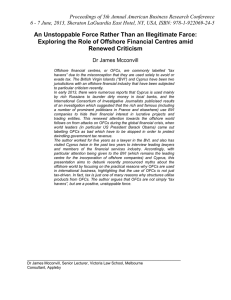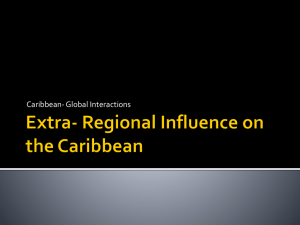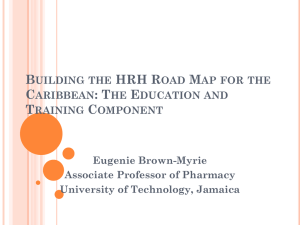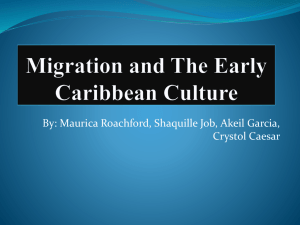Offshore Financial Centers
advertisement
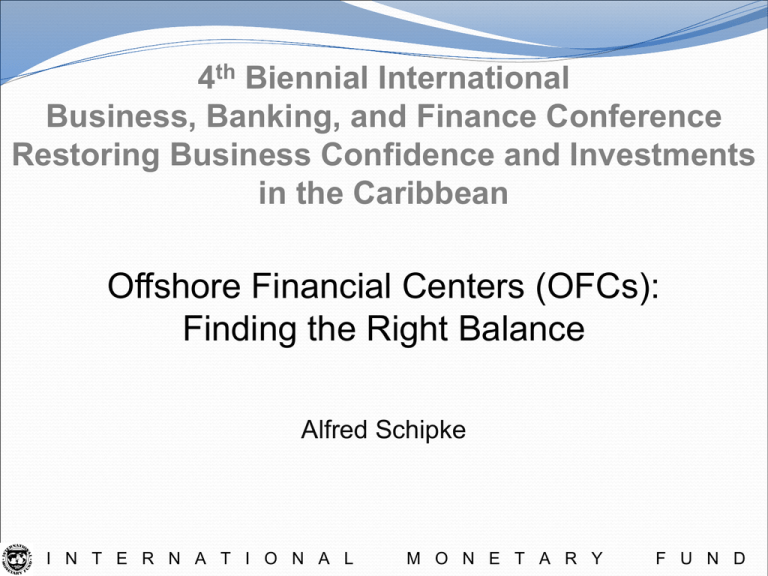
4th Biennial International Business, Banking, and Finance Conference Restoring Business Confidence and Investments in the Caribbean Offshore Financial Centers (OFCs): Finding the Right Balance Alfred Schipke I N T E R N A T I O N A L M O N E T A R Y F U N D Bankers on the Beach Content Why the focus on OFCs? How important are they? Do OFCs foster economic growth? Taxonomy of global initiatives and implications for OFCs? What are the implications of compliance/noncompliance? Takeaways Why the focus on OFCs? In the Caribbean Global level Faced with a more Implications of global challenging global environment, including more subdued tourism related growth prospects, search for areas to diversify economies Offshore financial services seen as important and vital part OFCs have also been at the center of financial crises (e.g. Stanford scandal and the failure of Bank of Antigua) economic and financial crisis have accelerated efforts by advanced economies to increase revenue and strengthen global financial systems Global initiative are targeting OFCs and the tax and regulatory environments in which they operate Financial services offered by OFCs Advantages of OFCs: International Banking relatively low start-up costs, attractive tax regimes, and privacy/secrecy rules Regulatory requirements are less stringent than for onshore financial institutions Headquarter Services Foreign Direct Investment Structured Finance Insurance Collective Investment Schemes Other services OFCs balances sheets increased Caribbean accounts for a large share of OFCs CPIS: Assets and liabilities of the 40 reporting OFCs are about U.S.$ 5 trillion (10 percent of world cross-border holdings) The wider Caribbean held about 60 percent of the estimated balance sheets managed of OFCs (BIS similar picture) Within the Caribbean, nonsovereign jurisdictions account for the largest stock OFC assets/liabilities Barbados and the Bahamas are the most important countries What are the benefits of OFCs? Income from direct employment Benefits via spillovers to other sectors in the economy including other services (such as tourism) and infrastructure (e.g. telecommunication and transportation) Government revenue from taxes and fees Caribbean Countries: Selected Indicators of Economic Contribution of OFCs, 2008 Antigua and Barbuda Bahamas Barbados St Kitts and Nevis 2 64 800 105 50 1,300 … … Government revenue from sector in percent of total revenue in percent of GDP 0.2 0.05 0.05 0.01 11 4 2.1 0.8 Employment in the sector in percent of banking sector employment in percent of total labor force 271 … … 1,163 23 … 3,500 … 2.5 … … … 9,630 … 74,200 1.7 … … … … 1 7.4-9.2 7.8 … Total Assets (US$ billions) in percent of GDP Average salary in sector (US$) ratio with domestic sector Contribution of sector to GDP (in percent) 1/ 1/ Staff estimates based on contribution of this sector to revenue flows, employment and services. Do OFCs foster economic growth? Empirical evidence that higher OFCs-related capital inflows have a positive impact on economic growth Results in line with Hines (2010) The results hold irrespective of whether a country/jurisdiction is classified as a taxheaven or not Dependent Variable: Real GDP Growth Rate (in percentage points) Growth Rate of PIL Growth Rate of Export Gross FDI (USD mln) Model1 Model2 Model3 Model4 Model5 Model6 0.009** (2.39) 0.062*** (4.03) 0.036** (2.44) 0.009** (2.43) 0.058*** (4.30) 0.027* (1.86) 0.011* (2.44) 0.010* (2.51) 0.011* (2.43) 0.010* (2.50) 0.040** (2.66) 0.042* (2.12) 0.029* (2.00) 0.034 (1.62) 0.043* (2.19) 0.039 (1.89) 0.034 (1.64) 0.024 (1.19) 3.877*** (11.29) -0.67 (-1.45) 4.254*** (13.76) 4.150*** (12.23) -0.846 (-1.57) 4.650*** (11.29) 4.183*** (12.28) -0.924 (-1.71) 4.731*** (11.36) 160 0.23 10.74 160 0.24 9.06 160 0.15 8.33 160 0.17 6.46 160 0.14 6.77 160 0.16 5.45 L.Growth Rate of Export L.Gross FDI (USD mln) Tax Haven Constant N R2 F-Stat Concern that global initiatives might undermine opportunities In search for revenue, advanced economies have focused on closing loopholes including by going after socalled tax havens Efforts to strengthen global financial system, including increased pressure for OFC host countries/jurisdictions to raise their adherence to financial standards and information sharing Despite differences, global initiatives share many of same objectives, with similar implications: Risk of “naming and shaming” (black list) Severe reputational risks Possible sanctions Good understanding of initiatives is needed to minimize adverse implications Commitment to international standards Caribbean countries have demonstrated commitment to meet international standards (e.g. TIEAs) While a number of Caribbean countries fared relatively weak in the FTAF snapshot list, they are making efforts to increase compliance FSB—has not yet published a list of non-compliant countries/jurisdictions Increased efforts need to ensure continued compliance increase costs Table 2. Status of OECD's List: International Tax Standard Number of Agreements Sovereign The Bahamas Barbados Belize Antigua and Barbuda Dominica Grenada Panama St. Kitts and Nevis St. Lucia St. Vincent and the Grenadines Overseas Territories Aruba Bermuda British Virgin Islands Cayman Islands Netherlands Antilles US Virgin Islands Montserrat Turks and Caicos Islands Source: OECD (As of January 19, 2011) April 09 1 12+ 0 7 1 1 0 0 0 0 Jan 11 12+ 12+ 12+ 12+ 12+ 12+ 10 12+ 12+ 12+ Latest Status White White White White White White Grey White White White 4 3 3 8 7 12+ 0 0 12+ 12+ 12+ 12+ 12+ 12+ 11 12+ White White White White White White Grey White Adverse implications of “grey”/ “blacklisted” OFCs Large international financial institutions exited from OFCs in countries placed on “grey “/”black” lists Grey/black listed OFCs experienced a decline in their share of global capital flows relative to their “white” listed competitors Signing of TIEAs has had a positive impact on portfolio capital flows Dependant variables: growth rate of shares in world total (country FE) Assets Liabilities Adj_Balance Grey Black Constant N Number of groups R2 overall F-Stat -0.1514 (-1.14) -0.1791 (-1.33) 0.0978 (1.36) -0.0463** (-2.30) 0.0467 (0.53) 0.0270** (2.39) -0.0314** (-2.46) -0.0462** (-2.27) 0.0207*** (2.98) 120 30 0.0054 1.45 120 30 0.0570 3.24 120 30 0.0134 3.45 Note: Coefficients in parentheses are t values. *, **, *** denote significance level at 10, 5, 1 percent, respectively Good regulatory standards positive for capital inflows Some evidence that countries/ jurisdictions that adopt higher regulatory standards benefit from higher capital flows Countries/jurisdictions that intend to expand OFCs, should strive to adopt good regulatory standards Dependent variable: countries' PIL share in the world Tax Haven Model1 Model2 Model3 Model4 Model5 0.005** (2.86) 0.000 (0.58) 0.006** (2.75) 0.000*** (4.48) -0.005 (-1.37) 0.000** (3.07) 0.000* (2.10) 0.003*** (7.76) 0.011*** (3.53) 0.002*** (5.07) -0.011*** (-3.49) -0.004 (-1.78) -0.009 (-1.92) 0.000 (1.91) 0.000 (1.90) 0.013*** (3.62) -0.003 (-1.11) Regulatory Quality TaxHaven*RegQuality Caribbean Constant R2 0.019 0.089 0.097 N 320 320 258 258 2 R 0.02 0.09 0.09 0.10 F-Stat 8.21 6.27 14.11 8.04 Note: Coefficients in parentheses are t values. *, **, *** denote significance level at 10, 5, 1 percent, respectively 0.165 258 0.17 5.68 Conclusions and recommendations Increased focus on OFCs both as a source of growth but also global initiates Countries/jurisdictions with OFCs account for a large share of cross-border holdings of financial assets/liabilities Evidence that OFCs contribute to growth Global initiatives (Global Forum, G-20, FSB, FATF) increase compliance costs Non-compliance adverse implications (risk of “naming and shaming”, reputation, possible sanctions)and lower capital flows High regulatory quality and compliance (TIEAs) benefit OFCs Conclusions and recommendations Countries/jurisdictions need to be proactive with respect to global standards/initiatives to maximize benefits; benefits and costs Because complying with increasingly higher standards is costly, countries and territories might want to evaluate the benefits and costs of providing OFC services. The smallest and most resource-constrained jurisdictions might want to take advantage of economies of scale and collaborate among themselves or create a regional body to provide accurate information about changing global standard requirements and technical assistance. The role of the IMF Supports the objectives of the international initiatives to foster transparency and the adoption of global standards As a member of the FSB is an advocate to support a level playing field Provides assistance (TA) to help members in upgrading standards Does not support “naming and shaming”, i.e. black/grey lists References Maria Gonzalez, Usman Khosa, Philip Liu, Alfred Schipke, Nita Thacker. Offshore Financial Centers: Opportunities and Challenges for the Caribbean. IMF Working Paper. 2011 Maria Gonzalez and Alfred Schipke. Bankers on the Beach. Finance and Development. Washington, D.C., June 2011. Regional First ECCU/IMF Economic Roundtable Outlook: Consultation Western Hemisphere Strengthening REO Titlethe Here Financial Sector Thank you 19 Fixed effects Dependent variable: Real GDP Growth Rate, country FE Model1 Model2 Growth Rate of Export Gross FDI (USD mln) Growth Rate of PIL 0.040** (2.40) 0.012 (1.13) 0.007** (2.08) 0.040** (2.40) 0.012 (1.13) 0.007* (2.43) Omitted 4.344*** (14.87) 4.344*** (14.87) 0.226 160 0.236 160 Tax Haven Constant R2 N Signing of TIAEs has had a positive impact Total TIEAs signed with country FE Assets Liabilities Adj_Balance Total number of TIEAs signed Constant N Number of groups R2 overall F-Stat 0.0139 (1.34) -0.0503 (-1.10) 0.0046* (1.96) -0.0216** (-2.08) 0.0039** (2.42) -0.0202*** (-2.80) 96 24 0.0039 1.8 96 24 0.0042 3.84 96 24 0.0014 5.85 Note: Coefficients in parentheses are t values. *, **, *** denote significance level at 10, 5, 1 percent, respectively … 160 140 Caribbean: Portfolio Investments (percent, shares) 120 Bahamas Bermuda Cayman Islands Others Barbados British Virgin Isl. Netherlands Ant. 100 80 60 40 20 0 2001 2002 2003 2004 2005 2006 2007 2008 2009 Turks & Caicos St Vincent & Gren. Caribbean: OFC Portfolio Investment (percent, share, average 2001-09) St Kitts & Nevis Netherlands Ant. Grenada Dominica Cayman Islands British Virgin Isl. Bermuda Belize Barbados Bahamas Aruba 120 Antigua & Barbuda … 140 Liabilities-debt Liabilities-equity 100 80 60 40 20 0 … 160 (percent, shares) 140 120 Caribbean-non-sovereign Caribbean-sovereign Europe East Asia Middle East Others 100 80 60 40 20 0 2001 2002 2003 2004 2005 2006 2007 2008 2009
